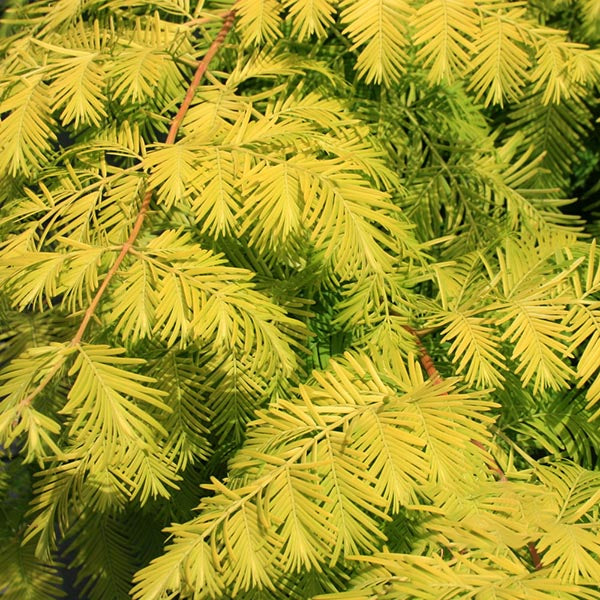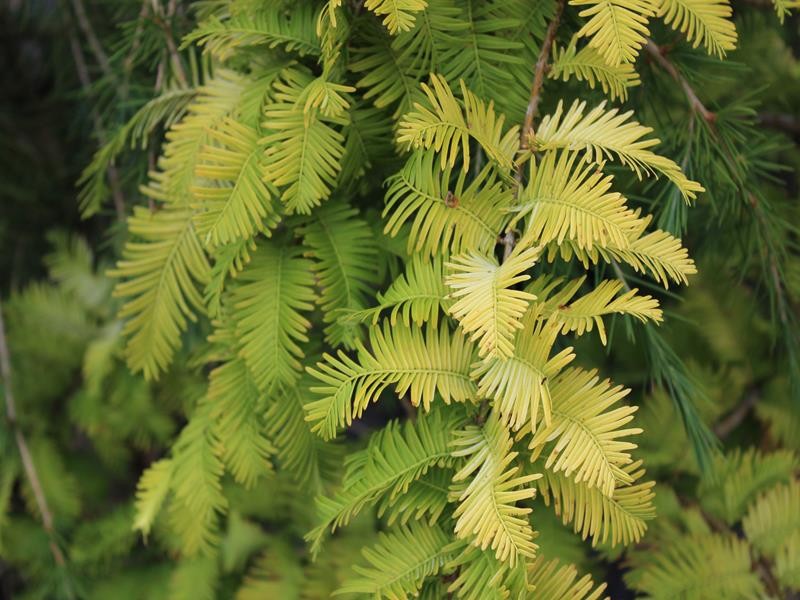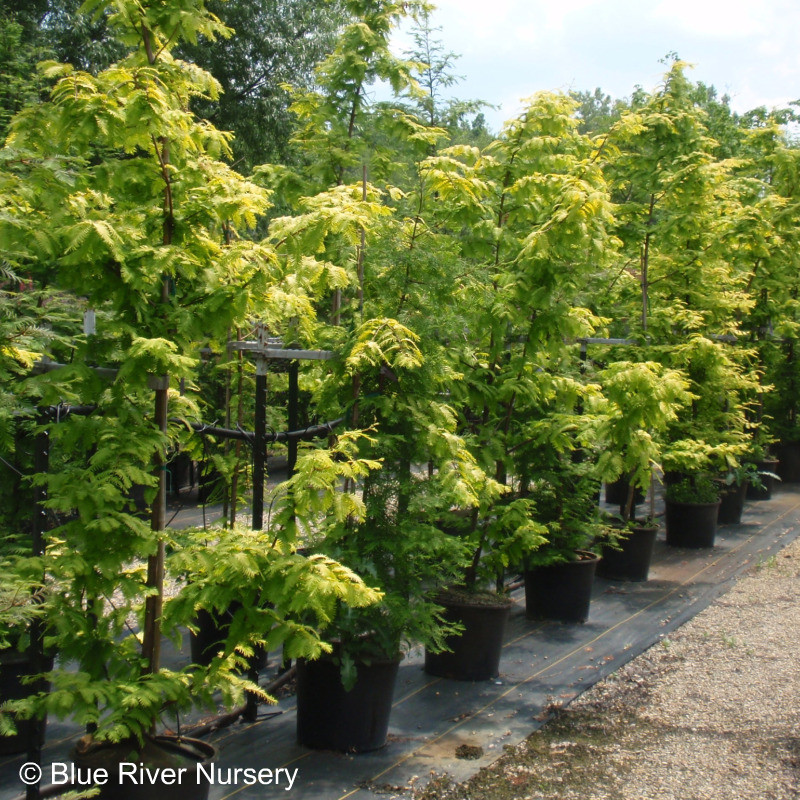

Genus name comes from the Greek words metra meaning with, after, sharing, or changed in nature and Sequoia to which it is related and to which fossil specimens were first referred. The twigs, needles and cone scales are in opposite pairs. Trees will typically rise to 10-15’ tall over the first 10 years, eventually maturing over time to 70-100’ tall. It reportedly grows somewhat slower than the species. Foliage gradually turns orange-brown in fall. Trees are monoecious, producing oval, light brown female cones (3/4” long) and pendant globose male cones (1/2” long). ‘Gold Rush’ is a cultivar that features soft, linear, feathery, fern-like foliage that is distinctively golden-yellow throughout summer. Foliage emerges light green in spring, matures to deep green in summer and turns red-bronze in fall. It features linear, feathery, fern-like foliage that is soft to the touch. The Gold Rush Dawn Redwood towers above other trees, often putting on up to twenty-four inches in one year. With a quick-growing nature and glowing gold foliage, it's easy to understand why. Bark on mature trees is often deeply fissured. And among Redwoods, the Gold Rush Dawn Redwood (Metasequoia glyptostroboides 'Gold Rush') is often considered the most highly sought-after. Believed to have come from irradiated seed. Plant first found in Japan, and known under the name 'Ogon'. As the tree matures, the trunk broadens at the base and develops attractive and sometimes elaborate fluting. Leaves yellow on opposite attached stems. Seedlings grown therefrom were planted in front of the Lehmann Building at MBG in 1952 where they have now developed into large mature trees (70’+ tall). Seeds collected from the original site were made available to the Missouri Botanical Garden in 1947. It is a fast-growing selection of dawn redwood with pleasing bright yellow feathery foliage that will turn tawny brown before being shed in the fall.

However, it was not until 1941 that it was first discovered growing in the wild near the town of Modaoqi, China by Chinese forester, T. Metasequoia glyptostroboides 'Ogon' is commonly known by the trade name Metasequoia glyptostroboides 'Gold Rush'. From fossil records, dawn redwood is known to have existed as many as 50,000,000 years ago. It is related to and closely resembles bald cypress ( Taxodium) and redwood ( Sequoia). Wet and clay soil tolerant.Metasequoia glyptostroboides, commonly called dawn redwood, is a deciduous, coniferous tree that grows in a conical shape to 100’ tall.
METASEQUOIA GOLDRUSH FULL
A full sun lover, this plant is easily grown in moist, well-drained or poorly drained soils.A single specimen is an imposing sight and groves are effective. This Metasequoia is much slower growing than most other dawn redwoods and is more suitable for gardens. The young leaves in spring are an attractive blueish-green in colour. A spectacular tree for stream banks or pond edges. A rare and slow growing selection, Metasequoia glyptostroboides 'Chubby' has bright green summer foliage which turns bronze in the autumn before falling. The russet-red fall color of its lacy needles, the interesting winter silhouette are some of the outstanding characteristics of Dawn Redwood. It is best suited to large gardens and parks. In autumn, the yellow turns to an unusual tawny- pinkish brown colour. It is a fast grower with attractive bright yellow feathery foliage. This is an unusual cultivar of the deciduous Dawn Redwood.

Oval, light brown female cones and pendant globose male cones are produced. Metasequoia glyptostroboides 'Gold Rush'. Reddish on young trees, the bark on mature trees is darker, often deeply fissured, and attractively flared at the base. Delicate flat sprays of narrow, bright green leaves emerge in spring, mature to emerald green in summer, before warming up to rich shades of yellow-brown, pink, apricot and copper in the fall. Unlike most cone-bearing trees, Dawn Redwood loses its foliage each winter. It features an upright, narrowly conical form that enhances many landscapes. A sight to behold, Metasequoia glyptostroboides (Dawn Redwood) is a large deciduous coniferous tree of great beauty.


 0 kommentar(er)
0 kommentar(er)
